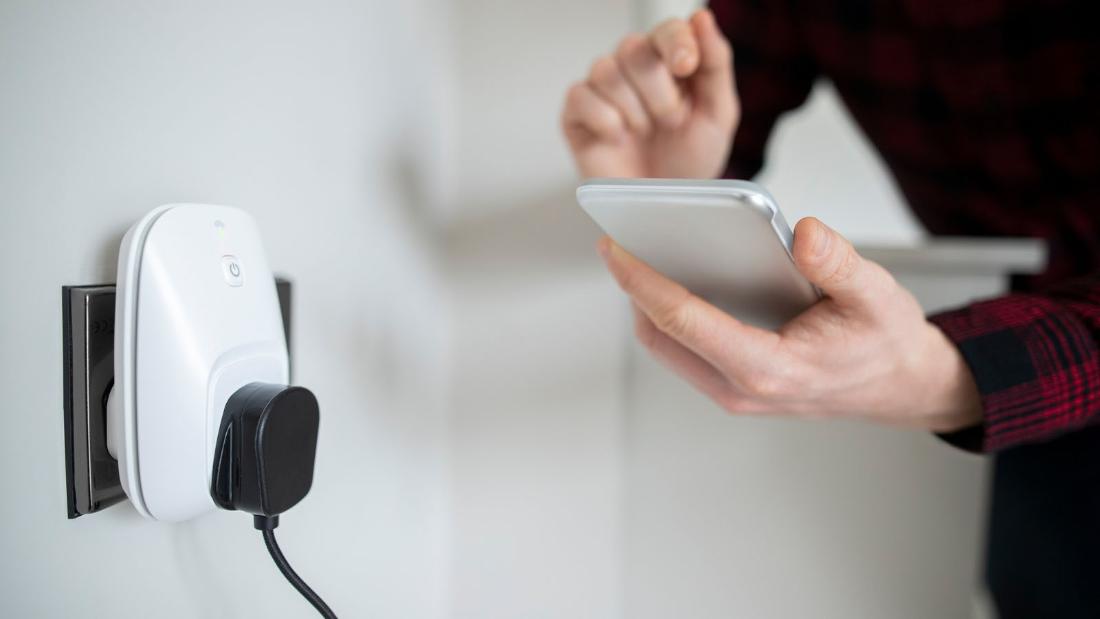(CNN) —
For those who want to enter the smart home realm without actually investing in smart devices, a smart plug — which adds a touch of automation to lamps, coffee machines and other everyday devices — is the way to go.
Essentially, a smart plug is a moveable outlet paired with connectivity to a smart home ecosystem — be it Amazon’s Alexa, the Google Assistant or Apple’s HomeKit. If you have multiple appliances you want to get online, there’s also smart outlet strips, which turn one regular outlet into many with smart control.
We researched hundreds of smart plug options — combing editorial and user reviews — to pull together the 11 most highly rated options. After weeks of testing, three options rose to the top:
Small (it doesn’t block other sockets when plugged in) and powerful (it connects to Amazon’s Alexa and the Google Assistant), the Wyze Plug features everything a smart plug should. The one downfall is no Apple HomeKit support. Quick to respond to prompts — along with the ability to create automations and schedules — the Wyze plug ($11.98; amazon.com) is a true workhorse.
Featuring the same highlights as the Wyze plug (easy setup, small design and quick response to cues), the Wemo Smart Plug ($19.99, originally $24.99; amazon.com) has an added benefit for those in the Apple ecosystem: it works with Apple HomeKit. In fact, it’s the preferred ecosystem when you’re setting Wemo up via an iOS device, yet still provides connectivity with Amazon Alexa and the Google Assistant.
Those who want to control multiple devices through one central hub have a superb option in the Monoprice Stitch power strip. The strip features four standard outlets, which can be controlled separately through its connected app and through Alexa or the Google Assistant. The Monoprice app handles all the legwork during setup, making it a cinch to get connected quickly. And, like the Wyze Plug, Apple HomeKit isn’t supported here. At just $29.99, it’s an affordable solution to easily control multiple outlets in a single package.
PHOTO: Jacob Krol/CNN
The Wyze Plug is a really unassuming device. It has everything a smart plug needs —- a plug to go into your current outlet, an outlet on the front to plug other devices in and connectivity to make it controllable —- and excels at the overall experience.
Included in the box is a QR Code you scan to connect the app to the plug. There are a few prompts, which get the gadget connected to your home’s Wi-Fi network, and then you’re set.
In terms of responding to commands, the Wyze plug handled prompts within a second. You can create timers, and compared to the Wemo, the Wyze’s experience is a bit more intuitive as it offers a quick scroll menu for selecting the time. For instance, we set up an automation for the Wyze to turn on our coffee machine at 7:45 every morning to start the brew process. And for those who want to conserve energy, it can automatically turn outlets (and the corresponding items plugged in) off at the end of the day. If you desire manual control, there’s a button on the side of the Wyze to turn it on or off.
Even more importantly, it was a bit more accurate than the Wemo when turning power on and off by about half a second. This makes it handier for some use-case like warming up a coffee machine or making a traditional lamp a smart one.
The Wyze plug also offers a vacation mode, something the Wemo does not. This way if the plug is attached to a lamp in a window, it will appear that the light is turning on and off throughout the day as if you’re home. Since it’s built in, you don’t need to mess around with creating your own automation.
While the Wyze plug shines within the Amazon or Google smart home ecosystem, it doesn’t offer support to connect within the Apple HomeKit setup. That makes it a bit less universal, but for the price you can’t beat it – especially if you plan to just use the companion app, Alexa or the Google Assistant. And while not as compact as the Wemo, the Wyze plug delivers huge value at $12.
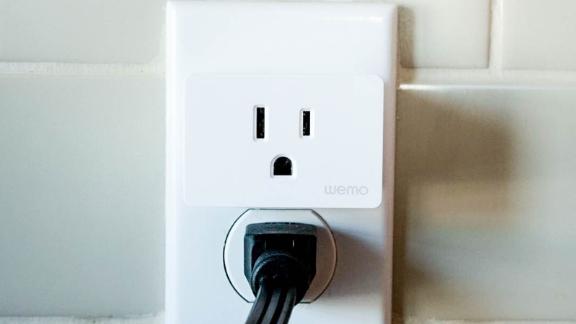
PHOTO: Jacob Krol/CNN
When it comes to smart plugs working within Apple HomeKit, the Wemo Plug quite simply stole the show.
The Wemo Plug is the only one we tested to offer support for all three major smart home ecosystems — Apple HomeKit, Amazon Alexa, and Google Assistant. (While the Philips Hue Plug can connect to all three, it’s only rated for use with lamps.)
Setup defaults to Apple’s ecosystem when setting up through an iOS device. If you’re not within the HomeKit ecosystem, you can ignore the respective popup (for around 10 to 15 minutes) to set up the plug through the Wemo app in order to connect with Alexa or the Google Assistant. On Android, you won’t have to worry about this popup.If you only want to play within the Apple ecosystem you don’t even need to get the Wemo app. You can just scan the barcode on the side of the plug within the Home app on your iOS device for easy set up that is completed in just seconds. After that, the Wemo Smart Plug is ready to shine.
We found the Wemo Plug to be almost instantaneous during everyday use. It took about a second to register a command (like turning the plug on or off) whether we were controlling it using the Wemo app or a smart assistant; some of the other plugs we tested took a good few seconds. Like the Wyze, the Wemo allows users to create automations to set a schedule for the plug to follow and even use an away mode, which cycles the power to mimic what you would do if you were home. Unlike the Wyze Vacation Mode, which has a preset solution, Wemo offers more customization, but in turn requires a bit more setup.
Despite all that functionality, the Wemo Plug is really tiny —- in fact, it’s the smallest smart plug we tested. It leaves ample room in a standard two socket outlet, something that at times can be crucial. It comes in just one color, white, with a glossy front that doesn’t call much attention.
The $24.99 Wemo Plug hits all its marks using a super small package and is ideal for the Apple HomeKit user. It’s extremely handy and boasts support for multiple smart ecosystems. It’s also the cheapest option for a smart plug within the HomeKit ecosystem.
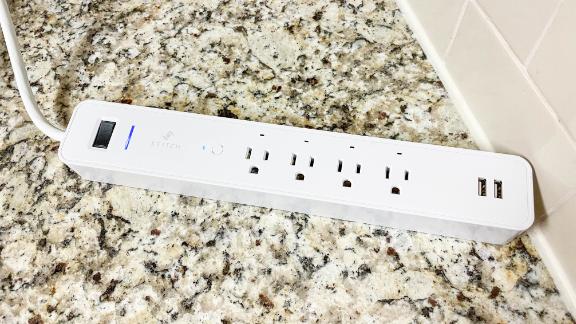
PHOTO: Jacob Krol/CNN
The Monoprice Stitch is akin to the Wyze smart plug — just in a strip form. It offers easy setup, simple controls and support for Amazon Alexa and Google Assistant, but no Apple HomeKit integration.
The Monoprice Stitch was the fastest to set up out of all the smart strips we tested. All we had to do to get started was plug it in, download the app and connect it to compatible devices. We were up and running in under 10 seconds, and we really appreciated not having to manually connect to the strip over Bluetooth.
One shortcoming (pun intended): The Monoprice’s cord comes in just shy of 20-inches long. While perfect for a kitchen countertop with a few appliances connected, it can get a bit tricky, perhaps, for a home office setup that might require plugins at different lengths and from different directions.
The Monoprice comes with four standard outlets and two USB-A ports. Each of the four sockets can be controlled individually, meaning you can keep outlet one and three turned on while delivering no power through two and four. These controls can come manually through the app, or by voice cues through your Amazon or Google smart assistant (if you’re looking for Apple HomeKit connectivity, your best option is the Eve Energy power strip).
Within the Monoprice app you can set timers and even create routines for each individual outlet. When testing in a kitchen, for instance, we could have one outlet turn on the coffee machine in the morning for a set amount of time, and in the evening start pre-heating the toaster oven through another outlet.
Commands like turning an outlet or the whole strip on or off happen quickly. The Wi-Fi connectivity inside is strong (on par with our top pick and the much pricier $100 Eve Energy), but also may depend on the Wi-Fi connection in your home.
For the price, the Monoprice Stitch Power Strip delivers a dependable experience that is fast to react to commands. Like the Wemo or Wyze Plug, it offers a simple design that we have a feeling will work for most people.
After deciding on our testing pool by consulting experts, the most popular models and our knowledge of the smart home market, we got to testing. We focused on a few key areas, taking special note of how intuitive they were to set up, whether they blocked other sockets and the universality of each plug’s connectivity.
We started evaluating from the moment each plug arrived, noting what was needed for setup and how seamless the experience was. Did we need to download a standalone app, and was an account required to use it? Could the plug easily integrate with Amazon Alexa, Apple HomeKit or the Google Assistant? If it had a separate application, did that deliver any special features like timers, an away mode or the ability to create routines?
In terms of ease of use, we tested for latency by turning the outlet on and off through every way possible. We also measured how long it took to deliver the desired response. In terms of power, we examined the wattage of each plug and whether or not it offered energy consumption monitoring.
We used the below categories and subcategories to score smart plugs and strips.
- Setup had a maximum of 25 points: overall (25 points).
- Smart home connectivity had a maximum of 15 points: Amazon Alexa (5 points), Apple HomeKit (5 points) and Google Assistant (5 points)
- Ease of use had a maximum of 15 points: overall (15 points).
- Build had a maximum of 10 points: overall (10 points).
- Power had a maximum of 10 points: output (5 points) and energy consumption tracking (5 points).
- Warranty had a maximum of 5 points: overall (5 points).
Amazon Smart Plug ($24.99; amazon.com)
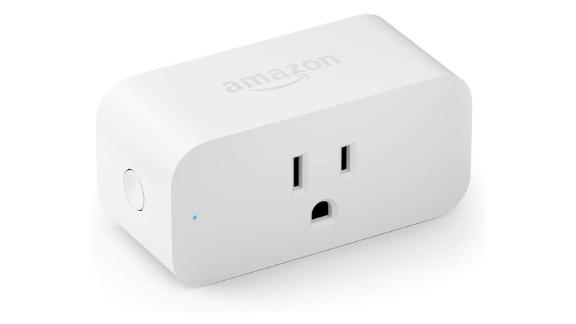
PHOTO: Amazon
Amazon Smart Plug
As the name suggests, the Amazon Smart Plug works exclusively with Echo smart speakers and smart displays, making it much more niche than our overall winners. It’s an Alexa gadget and works wonderfully within that ecosystem. It’s seamless to set up and use —- but at the price it has a larger design that’s quite long and it’s a bit more expensive than our other picks.
Eufy Smart Plug ($22.99; amazon.com)
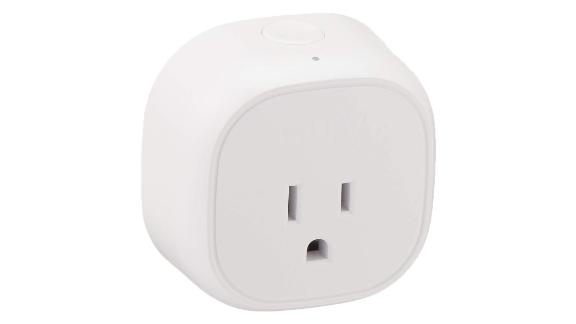
PHOTO: Amazon
Eufy Smart Plug
The Eufy Smart Plug has the most unique design out of the plugs we tested. It’s a rounded square with the plug located on the bottom. It takes up a lot of space, though, and only gives you one extra plug. There’s a physical button for power control and an LED indicator. Setup took a bit longer on this one and it only works with Amazon Alexa.
Eve Energy Smart Strip ($99.95; amazon.com)
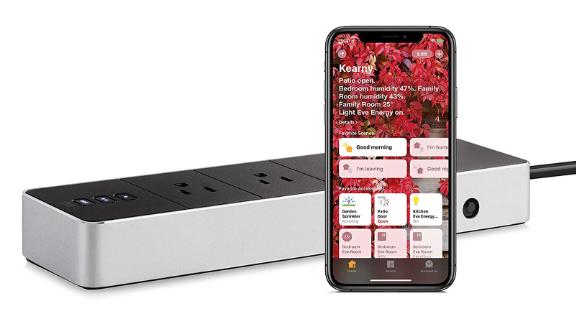
PHOTO: Amazon
Eve Energy Smart Strip
If looks counted the most in our scoring, the Eve Energy Smart Strip would be the winner. It features an aluminum design that feels super high-end. But at nearly $100, it features only three ports and only works with HomeKit. You do get full energy consumption monitoring and the ability to turn individual outlets on or off.
Kasa Smart Plug ($9.99, originally $14.99; amazon.com)
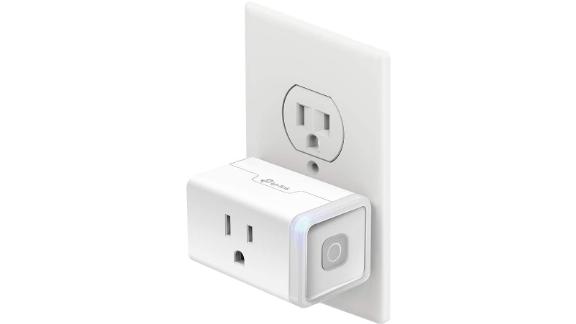
PHOTO: Amazon
Kasa Smart Plug
TP-Link’s Kasa Smart Plug is smaller than most of the smart plugs we tested. The right edge of this plug features an LED indicator and it’s the brightest one we saw. Using the Kasa app on your Android or iOS device, you can set customizations, monitor the plug and even set a schedule. You can also connect it with Amazon Alexa or the Google Assistant. Ultimately Kasa lost points and value in our eyes due to its less-than-intuitive app and the fact it didn’t always hold the strongest connection to the plug itself.
Kasa Smart Outlet Strip ($26.99, originally $39.99; amazon.com)
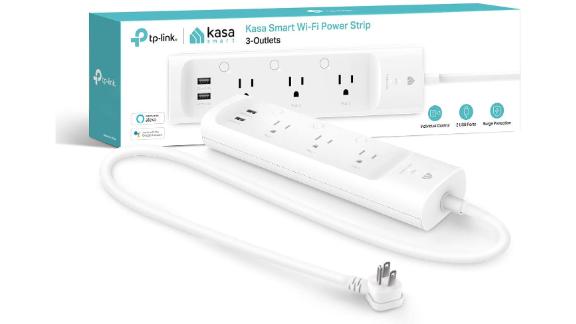
PHOTO: Amazon
Kasa Smart Outlet Strip
This Smart Outlet Strip features three individually controllable outlets and two USB-A ports. Using the Kasa app for Android or iOS, you can set up the strip and pair it with Amazon Alexa or the Google Assistant. We ultimately found other apps a bit easier to use, but did like the overall build of the Kasa. It also has a longer cord, but less outlets in comparison with the Monoprice Stitch strip.
Philips Hue Smart Plug ($34.99; amazon.com)
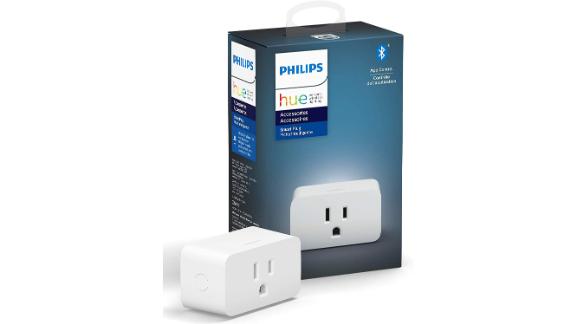
PHOTO: Amazon
Philips Hue Smart Plug
Like the Wemo Plug, Philips Hue’s offering can work with all three core ecosystems. You can connect it to an existing Philips Hue system with a bridge for out of home control or use Bluetooth for in-home control. It’s only rated for lamps and lights though —- so no appliances can be controlled here. For that reason Wyze or Wemo is better for most use cases.
Satechi Dual Outlet Plug ($59.99; amazon.com)
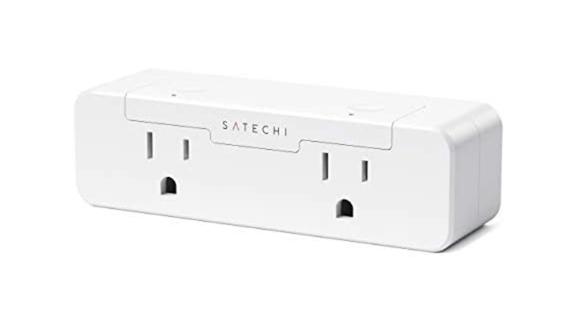
PHOTO: Amazon
Satechi Dual Outlet Plug
The Satechi delivers a smart plug that is built from the ground up for Apple’s HomeKit and turns one outlet into two. Via the Home app, you can turn each outlet on or off and create routines. It is pretty large, though, so make sure you have space and that you can stomach the nearly $60 price point.
Wemo Mini Smart Plug ($24.94, originally $34.99; amazon.com)
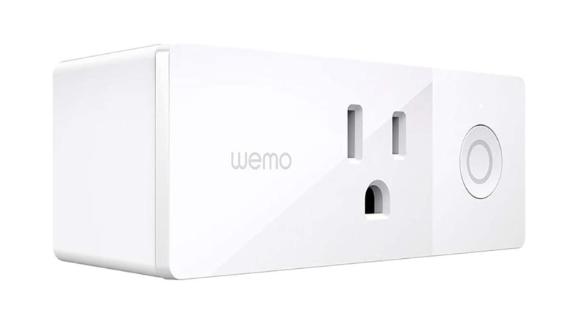
PHOTO: Amazon
Wemo Mini Smart Plug
Here’s the funny thing about the Wemo Mini Smart Plug —- it’s twice the size of the Wemo Plug. It works within the same Wemo app and supports Apple HomeKit, Alexa and the Google Assistant. And at $34.99, it’s $10 more than our top pick, the Wemo Plug, making it less desirable overall.
Read more from CNN Underscored’s hands-on testing:
